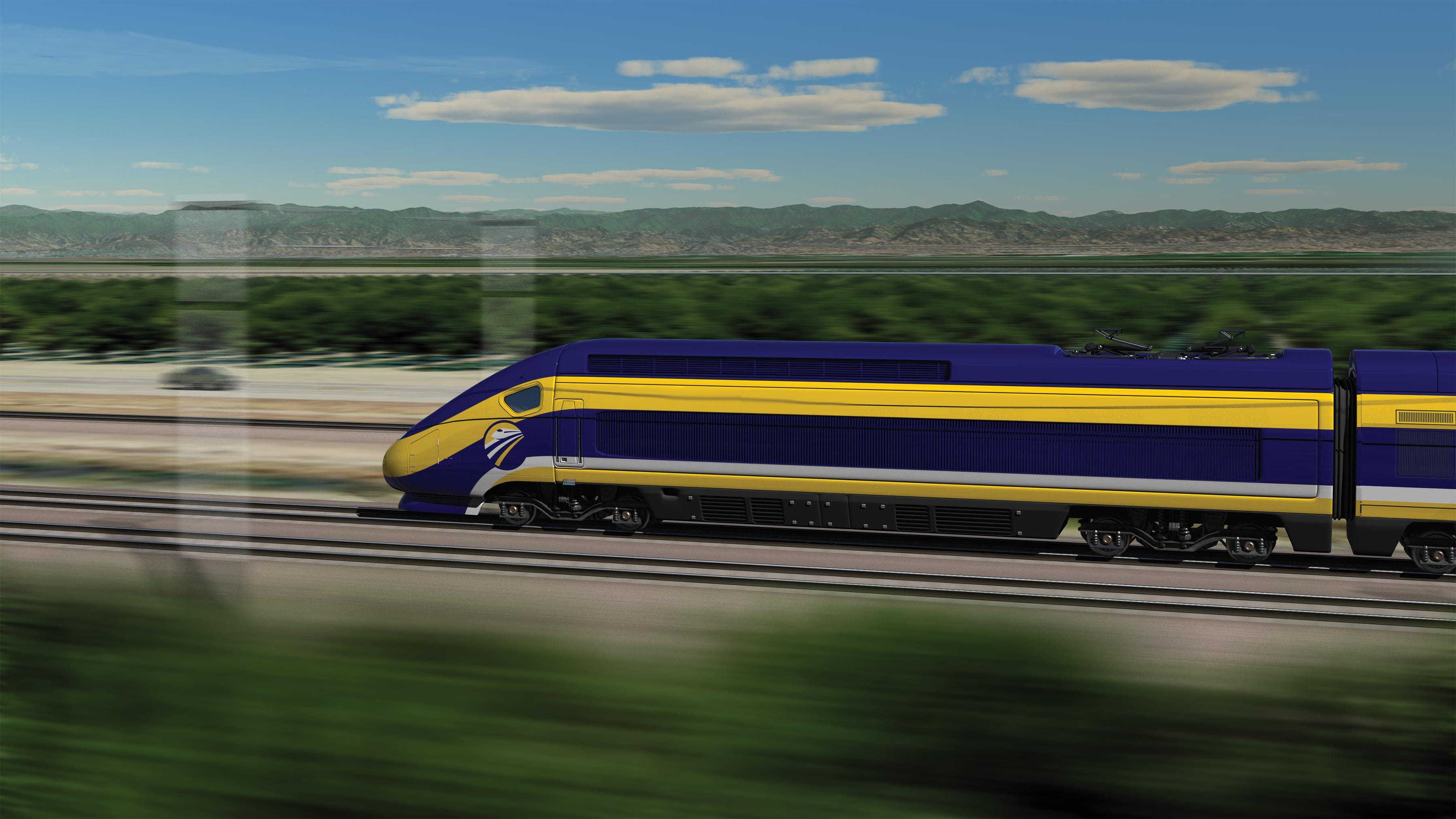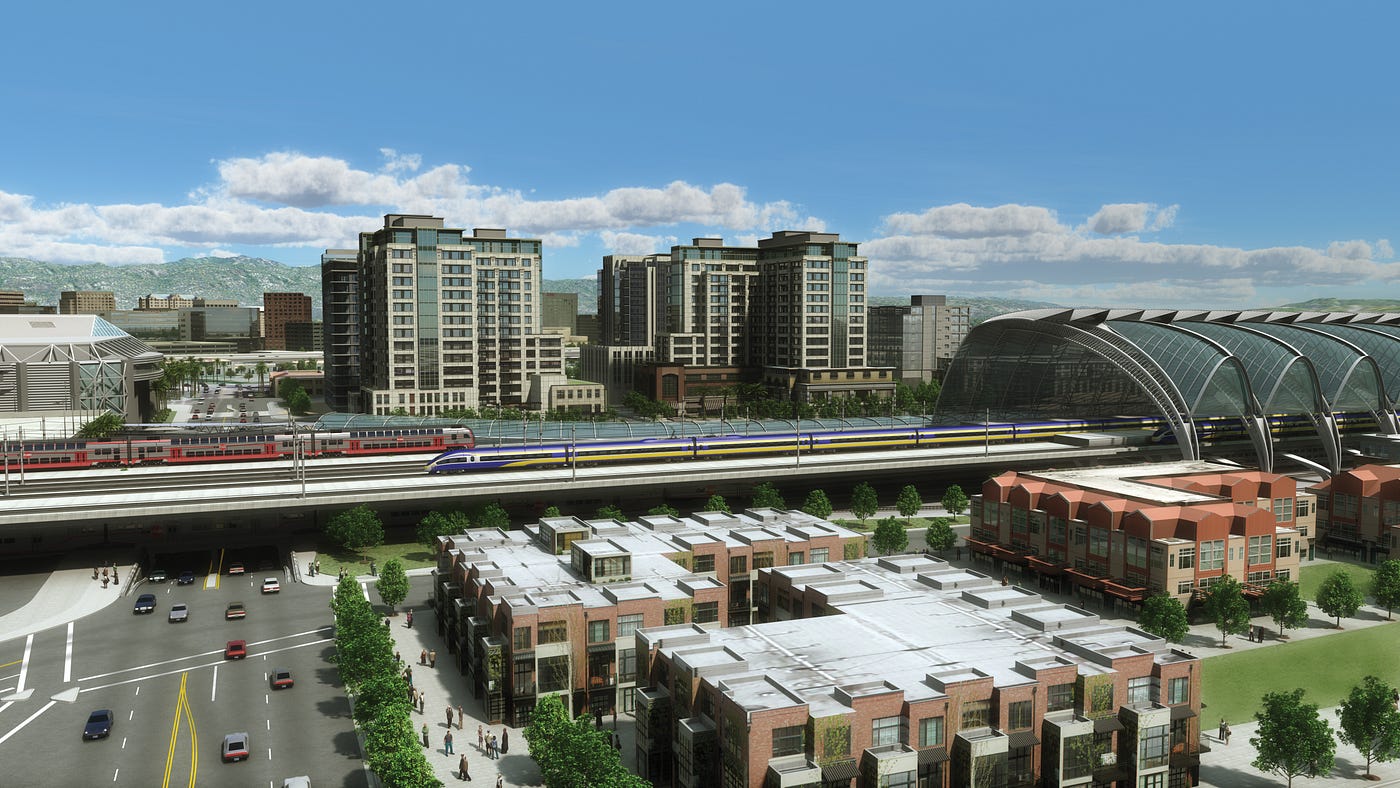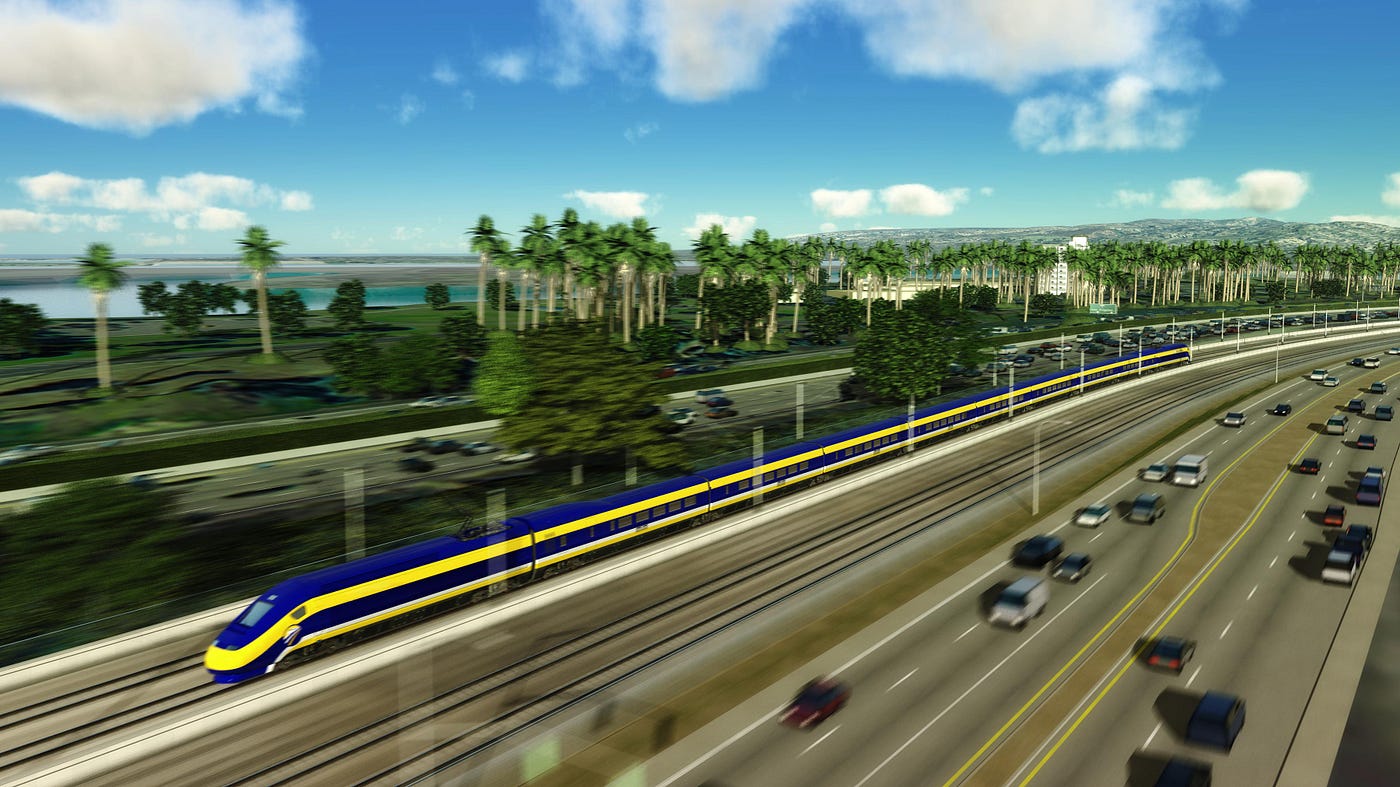
Picture this: It’s 2040. Travelers in San Francisco board a sleek electric train bound for Los Angeles. They don’t deal with the hassle of airport security, and they don’t get stuck in California’s infamous gridlock. Instead, they comfortably traverse the length of the state in less than three hours, stepping off into downtown LA. Because of this train, the atmosphere is spared more than 1.5 million metric tons of carbon dioxide every year (the equivalent of 322,000 cars) as well as nearly four tons’ worth of fewer pollutants—not to mention the 169 million metric tons of gasoline saved annually.
Now imagine another scenario: It’s 2040, again, but this time no such train exists. In California, 544 million interregional trips are made every year, and with limited public transportation, the vast majority take place by car. Roadways, already congested in 2019, are now horrifically gridlocked in major urban centers such as Los Angeles and San Francisco. The Central Valley remains underserved. Residents are forced to rely on automobiles, driving long distances to work. The high-speed rail once discussed but never put into place would have saved hundreds of thousands of tons of automobile emissions, but without it, those pollutants are continuing to choke the Valley, which has some of the worst air quality in the nation.
Despite the recent headlines, California’s high-speed rail isn’t dead, and its proponents are still fighting hard to make it happen.
The high-speed rail connecting Northern and Southern California has been discussed for decades, with billions of dollars already having been poured into the project. But the dire state of the second scenario began to appear much more likely than the first in recent weeks after governor Gavin Newsom made headlines following his announcement that he would be scaling the project back significantly to complete only the Central Valley leg, which would connect Merced to Bakersfield. On top of that, at the same time, the Trump administration threatened to pull federal funding from the already budget-challenged project.
While Newsom’s initial announcement got most of the attention, many missed the fact that he later backpedaled and said the full project would be completed — eventually — but with little details on how and when that would happen. So despite the recent headlines, California’s high-speed rail isn’t dead, and its proponents are still fighting hard to make it happen.

The reality is that California is running out of space quickly, and the mythical train may be the only solution for our huge and massively populated state. Yes, the decades-long project has an always rising price tag and ongoing legal battles over its route. It won’t be easy to get done—it’s going to take some brave-faced politicians to suck up the massive costs and have the courage to make the first high-speed rail in America happen. But transit- and urban-planning experts nearly all agree that it’s not only the reasonable option for California’s future — it’s the only one, and here’s why.
Reducing California’s Carbon Footprint
California is known for its environmental stewardship and forward-thinking policy on climate issues; our emissions programs and recent clean-energy bill are groundbreaking. The state has consistently advocated for environmental responsibility above federal standards. In spite of that, however, we have one glaring environmental issue: we are extremely car dependent.
While the state has made headway in reducing overall emissions — 12 percent since 2006 — transportation-related emissions remain stubbornly high and have even increased during recent years, given that the housing shortage and skyrocketing costs of living in urban centers are causing more people to drive.
The goal is to create a dedicated passenger rail, one that doesn’t compete with freight rail; moves quickly; is clean and electric; connects people throughout California; and reinforces existing city centers.
Urban cores like San Francisco have decent public transit, but outside city centers — where people in California are increasingly living — fewer options exist. That’s the gap the high-speed rail could fill, experts hope.
Egon Terplan, the regional planning director of the San Francisco Bay Area Planning and Urban Research Association (SPUR), said the goal is to create a dedicated passenger rail, one that doesn’t compete with freight rail; moves quickly; is clean and electric; connects people throughout California; and reinforces existing city centers. It’s all about “fundamentally changing the way we grow and move around as a state.”
As California continues to grow — the population is expected to reach 50 million by 2050 (compared to our current 39 million) — the state needs to find ways to move groups of people across large distances.
“We made a policy choice 60 years ago with the rise of the automobile to build our cities differently and remove rail. We’re trying to shift back,” Terplan said. “And from an environmental perspective, we don’t really have any other option.”

It’s true that the high-speed-rail project has been challenged on environmental grounds due to threats it may pose to delicate habitats on its route, as well as from farmers who could lose portions of their fields in the Central Valley, but Terplan argues that the long-term potential far outweighs the short-term impacts. As California continues to grow — the population is expected to reach 50 million by 2050 (compared to our current 39 million) — the state needs to find ways to move groups of people across large distances. Without rail, we will likely lean more heavily on traditional methods with high carbon impacts.
“You have to compare it to the alternative, which is either additional lanes on Interstates 5 and 99 or additional runways and security checkpoints at airports,” Terplan said. “Those require much, much bigger price tags and a much, much larger environmental impact.”
Building a More Vibrant Central Valley
The high-speed-rail project is also designed to revitalize the middle of the state, especially the Central Valley, both through the mobility the rail will bring and the jobs needed to build it. The project has already brought about $2 billion in economic activity and thousands of jobs.
Critics mocked Newsom’s announcement to focus the rail project on the Central Valley and connect Bakersfield and Merced, calling it a “train to nowhere,” but it appears that the governor is betting on the project revitalizing the area—and in the meantime, California can determine funding streams to finish the rest of it.
The idea is that the rail project would also tempt the economic powerhouses of Northern California — tech companies and others — to build satellite offices in the Valley rather than to locate their secondary headquarters in cheaper cities, such as Phoenix or Austin, explained Boris Lipkin, the director of the Northern California division of the California High-Speed Rail Authority.
Critics mocked Newsom’s announcement to focus the rail project on the Central Valley and connect Bakersfield and Merced, calling it a “train to nowhere,” but it appears that the governor is betting on the project revitalizing the area—and in the meantime, California can determine funding streams to finish the rest of it. Unlike other infrastructure projects, rail can function even when it’s not complete; a half-built bridge can’t be crossed, but a half-built rail track can connect two cities along the larger route.
“Once you start to tie these places together, then the whole is greater than the sum of its parts,” Lipkin said. “It’s easier for companies to locate in other parts of the state. People can find job opportunities. It will change the entire economy of the state.”
Confronting Roadblocks
The obstacles in the way of the rail project are myriad and complex; the project has been and will continue to be expensive, with the total cost estimated to be nearly $80 billion at this point.
Originally, the project cost was estimated at $35 billion, but inflation and roadblocks have pushed it up. If the Trump administration goes ahead with pulling the project’s funding, there will be time lost spent fighting to get it back. The project has received $2.5 billion in federal funds so far — which the Trump administration has said they will try to force California to return — and is supposed to have another $929 million coming.
Finding the money to finish the project is going to be a monumental challenge. Voters first passed a bond to fund the high-speed rail in 2008, but the $10 billion from that was just seed money. Lipkin said that funding will have to come from “diverse sources” — the private sector, state money and federal funding — but at this stage, he didn’t have a clear answer for how the High Speed Rail Authority will obtain it.
“What we have to do is continue to advance the program and continue to advance the environmental clearance so that we can have a precise conversation about what we need,” he said.
The project also continues to be hindered by lawsuits, which is one of the uniquely American challenges the high-speed rail is facing. America’s project-management system for large infrastructure allows citizens to step in and voice concerns easily and frequently, which isn’t as common in Europe in Asia and tends to slow down projects like this, which operate on a large scale through multiple regions.

“We have created a system where process is really important, and that makes it difficult to move things forward,” Terplan said. “The system is in place to allow people to make critiques of projects and slow them down rather than achieving things based on overriding public interest.”
The high-speed rail represents a solution for the challenges on the horizon for a state on the verge of outgrowing its infrastructure.
The final challenge facing the project comes down to sheer lack of expertise. The United States let our passenger-rail system fall by the wayside decades ago, and most rail lines are now controlled by freight companies. At the same time, other countries have been investing in these projects for much longer.
Essentially, the high-speed-rail project goes against the grain of American policy.
“Other countries that have done a high-speed rail have more of a history of being effective at investing in infrastructure projects, like Korea and China,” Terplan said. “We don’t develop this expertise over the long term.”
But experts agree that just because we haven’t been successful in the past doesn’t mean we don’t need to try moving forward. The high-speed rail represents a solution for the challenges on the horizon for a state on the verge of outgrowing its infrastructure. To finish the high-speed rail, funding may have to be diverted from other transport projects, such as highway expansions or bigger airports, but that’s a choice that can be made.
“The notion that we don’t have resources for this is incorrect — it is a matter of prioritizing,” Terplan said.







